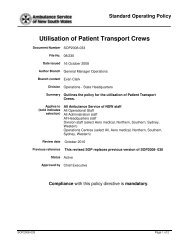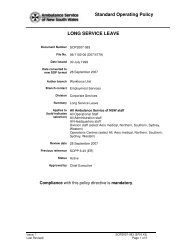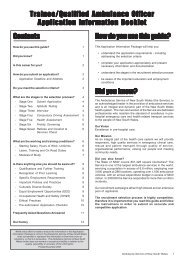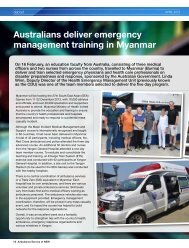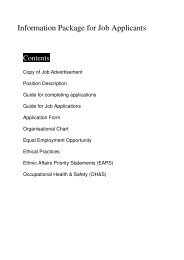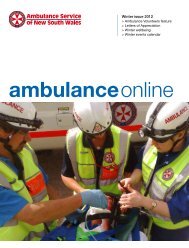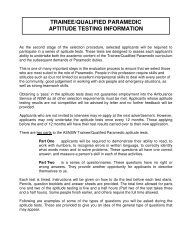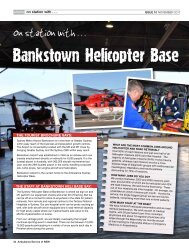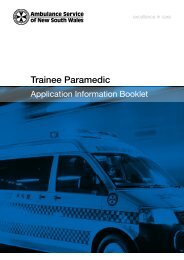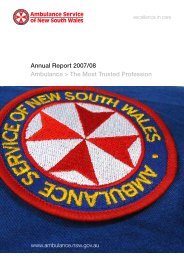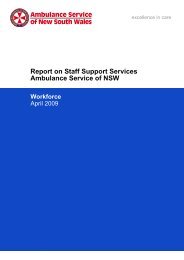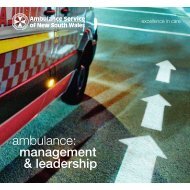Annual Report - Ambulance Service of NSW
Annual Report - Ambulance Service of NSW
Annual Report - Ambulance Service of NSW
Create successful ePaper yourself
Turn your PDF publications into a flip-book with our unique Google optimized e-Paper software.
Statutory and other information<strong>Ambulance</strong> PlanningProgress during 2006/07 developing<strong>Ambulance</strong> Five Year Strategic Plan> Completion <strong>of</strong> the <strong>Ambulance</strong> Five YearStrategic Plan, which adheres to formatrecommended by <strong>NSW</strong> Health and is astrategic fit to Health’s Future Directionsand <strong>Ambulance</strong>’s future challenges.> A foldout single page plan has beenpublished and distributed to <strong>Ambulance</strong>staff and is available on the intranet.> <strong>Ambulance</strong> Five Year Strategic Planformally approved by <strong>NSW</strong> Health.Progress during 2006/07 developing<strong>Ambulance</strong> <strong>Service</strong> Plans> Education Action Plan has been finalised.The first phase <strong>of</strong> developing the Clinical<strong>Service</strong>s Development Plan undertakento be followed up by a further workshopto draft a more detailed version.> The Corporate <strong>Service</strong>s functionalbusiness plans are currently undergoingdevelopment.> Business continuity plans developed inthe event <strong>of</strong> operational and or technicalinterruption, disruption or disaster usinga pre-defined, pre-tested, approvedcourse <strong>of</strong> action will be employed by keystakeholders in the recovery process.Key milestones for implementing Plans> A progress review <strong>of</strong> the <strong>Ambulance</strong> FiveYear Plan will be conducted to monitorkey milestones as envisaged in the plan.Key priorities/directions arising to date> To ensure <strong>Ambulance</strong> strategies andactions are consistent with the sevenstrategic directions <strong>of</strong> Health.> To ensure <strong>Ambulance</strong> planning reflectsthe 20 year future strategic horizon andthe five year planning framework.Future directions associated with the FiveYear <strong>Ambulance</strong> Plan> Substantial Government investment inambulance <strong>of</strong>ficers and technology willassist manage the expected increase indemand for services to 2010.> To enable changes to the type <strong>of</strong> servicesthat are being sought from modern dayambulance clinicians to contribute to thebroader spectrum <strong>of</strong> health care delivery.> Maintain the emphasis on increasing theclinical skills <strong>of</strong> ambulance <strong>of</strong>ficers andservices that are evolving from a “takingthe patient to care” to one that is “takingcare to the patient.”> Partnerships with health care providerswill be carefully developed to ensurereliable access to ongoing care.Committees <strong>of</strong> the <strong>Ambulance</strong> <strong>Service</strong>Committees <strong>of</strong> the <strong>Ambulance</strong> <strong>Service</strong> as at 30 June 2007Corporate Governance CommitteesFinance CommitteeThe primary function <strong>of</strong> the FinanceCommittee is to assist the Chief Executivein fulfilling responsibilities in respect <strong>of</strong> thefinancial management <strong>of</strong> <strong>Ambulance</strong>.Twelve Finance Committee meetings wereheld between 1 July 2006 and 30 June2007. Attendance by Council members:Greg Rochford12 meetingsBarrie Unsworth (Chair) 10 meetingsMaria Pethard9 meetingsAudit and Risk CommitteeThe primary function <strong>of</strong> the Audit and RiskCommittee is to assist the Chief Executiveby reviewing systems <strong>of</strong> financial accounting,systems <strong>of</strong> internal audit controls and theaudit process.Privacy information for patients<strong>Ambulance</strong> complies with the Privacy andPersonal Information Protection Act (1998)and the Health Records and InformationPrivacy Act (2002) (HRIP). The HRIP Actis designed to balance the protection<strong>of</strong> personal health information with thepublic interest in the legitimate use <strong>of</strong>that information. During 2006/07, oneapplication was received under the HealthRecords Information Privacy Act 2002 on 6October 2006. The outcome <strong>of</strong> the reviewidentified that <strong>Ambulance</strong> breached HealthPrivacy Principle 5 by not taking reasonablesteps to secure the information and HealthPrivacy Principle 10 by inadvertent use <strong>of</strong>the information. As a result, <strong>Ambulance</strong>implemented a policy about sendinginformation by a facsimile machine.Personal health information is collected whenan individual calls 000 and patient contactis made. When a patient is transported tohospital ambulance <strong>of</strong>ficers complete apatient health care record and leave a copywith the hospital. Only information thatis relevant and necessary for a patient’streatment and ongoing care is collected.All reasonable steps are taken to ensurethe information that is collected is storedsecurely. Patient health care records areretained for 25 years.Appropriate systems are in place to protectinformation from loss, unauthorised accessand misuse.Four Audit and Risk Committee meetingswere held between 1 July 2006 and 30 June2007. Attendance by Council members:Greg Rochford4 meetingsMaria Pethard3 meetingsLinda Barach3 meetingsJim Arneman2 meetingsStephen Flanagan2 meetingsClinical Governance CommitteeThe primary function <strong>of</strong> the ClinicalGovernance Committee is to assist the ChiefExecutive ensure the clinical quality and safety<strong>of</strong> care delivered and to establish and monitorprogress <strong>of</strong> clinical improvement strategies.Three Clinical Governance meetings wereheld between 1 July 2006 and 30 June2007. Attendance by Council members:Jon Isaacs (Chair)3 meetingsJim Arneman2 meetings<strong>Ambulance</strong> uses and discloses personalhealth information for the primary purposethat the information was collected. Underlegislation, information can also be usedand disclosed for purposes directly relatedto a patient’s treatment, in ways reasonablyexpected for a patient’s ongoing care.<strong>Ambulance</strong> is also required to disclosepatient information to State andCommonwealth government agencies tocomply with other laws and may also berequired to provide a copy <strong>of</strong> a patient healthcare record if it is subpoenaed for evidencein a court <strong>of</strong> law. Information is also used anddisclosed for billing, statutory reporting andother purposes required for the operation<strong>of</strong> <strong>Ambulance</strong>, which includes safety andquality improvement initiatives. Whererelevant, <strong>Ambulance</strong> may need to disclosepatient information to Medicare, privatehealth funds or the Department <strong>of</strong> Veterans’Affairs.Each patient is entitled to request accessto all personal information. A fee may becharged to provide a patient with a copy <strong>of</strong>their record. Requests should be in writingand addressed to:<strong>Ambulance</strong> <strong>Service</strong> <strong>of</strong> New South WalesMedical Records DepartmentPO Box 17HAMILTON <strong>NSW</strong> 2303Ph: (02) 4921 753460 <strong>Annual</strong> <strong>Report</strong> 2006/07 <strong>Ambulance</strong> <strong>Service</strong> <strong>of</strong> New South Wales



